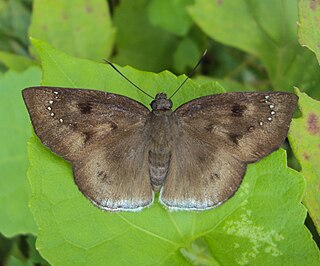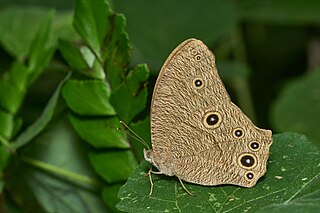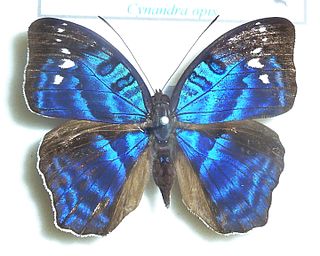Schausiana is a monotypic moth genus of the family Hepialidae described by Pierre Viette in 1950. The only described species is Schausiana trojesa, described by William Schaus in 1901, which is endemic to Mexico.

Aeromachus dubius, the dingy scrub-hopper, is a butterfly belonging to the family Hesperiidae. It ranges from India to China, including Malaya, Assam, Myanmar, Laos, Vietnam, Hainan and Yunnan.

Halpe porus, commonly known as Moore's ace, is a species of butterfly in the family Hesperiidae, found in India.

Odontoptilum angulata, the chestnut angle or banded angle, is a butterfly belonging to the family Hesperiidae and is found in India and southeast Asia.

Tagiades gana, the immaculate snow flat, large snow flat or suffused snow flat, is a butterfly belonging to the family Hesperiidae found in Indomalayan realm.

Melanitis leda, the common evening brown, is a common species of butterfly found flying at dusk. The flight of this species is erratic. They are found in Africa, South Asia and South-east Asia extending to parts of Australia.

Zizeeria karsandra, the dark grass blue, is a small butterfly first described by Frederic Moore in 1865. It is found from the southern Mediterranean, in a broad band to India, Sri Lanka, the Andaman and Nicobar islands, Myanmar, Thailand, Malaysia, Yunnan, Indonesia, the Philippines, Arabia, United Arab Emirates, Saudi Arabia and Oman, New Guinea and northern and eastern Australia. It belongs to the lycaenids or blues family, and the tribe Polyommatini.

Aglossa cuprina, the grease moth, is a snout moth, family Pyralidae, described by Philipp Christoph Zeller in 1872. The grease moth is closely related to the genus Pyralis, and as a result, is usually associated with the meal moth, Pyralis farinalis.
Jalmenus eubulus is a butterfly of the family Lycaenidae. It is found in the Australian states of New South Wales and Queensland, in the Murray-Darling basin. It was first described in 1876 by William Henry Miskin.
Stenoptilia petraea is a moth of the family Pterophoridae. It is known from India and Sri Lanka.
Cibyra ferruginosa is a species of moth of the family Hepialidae. It was described by Francis Walker in 1856 and is known to live in the northeastern region of Brazil.

Cynandra opis, the brilliant nymph, is a butterfly in the family Nymphalidae. It is the only species in the monotypic genus Cynandra. It is found in Guinea, Sierra Leone, Liberia, Ivory Coast, Ghana, Togo, Nigeria, Cameroon, Gabon, the Republic of the Congo, the Central African Republic, Angola, the Democratic Republic of the Congo, Uganda and Tanzania. The habitat consists of dense forests.
Ephoria dora is a moth in the Apatelodidae family. It was described by Schaus in 1896. It is found in south-eastern Brazil.
Langsdorfia coresa is a moth in the family Cossidae. It was described by William Schaus in 1901 and is found in Colombia.
Givira carisca is a moth in the family Cossidae. It is found in Mexico.
Givira quadra is a moth in the family Cossidae described by William Schaus in 1901. It is found in Costa Rica, Brazil and Paraguay.
Givira plagiata is a moth in the family Cossidae. It was described by William Schaus in 1901 and is found in Venezuela.
Elachista cucullata is a moth of the family Elachistidae. It is found in North America, where it has been recorded from California, Florida, Indiana, Maine, Massachusetts, Mississippi, New Jersey, New Mexico, Ohio, Ontario, Pennsylvania, Quebec and West Virginia.
Megalopyge brunneipennis is a moth of the family Megalopygidae. It was described by Schaus in 1905. It is found in Brazil.
Parafuscoptilia is a genus of moths in the family Pterophoridae, containing only one species, Parafuscoptilia tubuliformis. It was described in 2005 by Shu-Lian Hao and Hou-Hun Li from specimens collected in Fujian, China. It is placed to tribe Marasmarchini.







